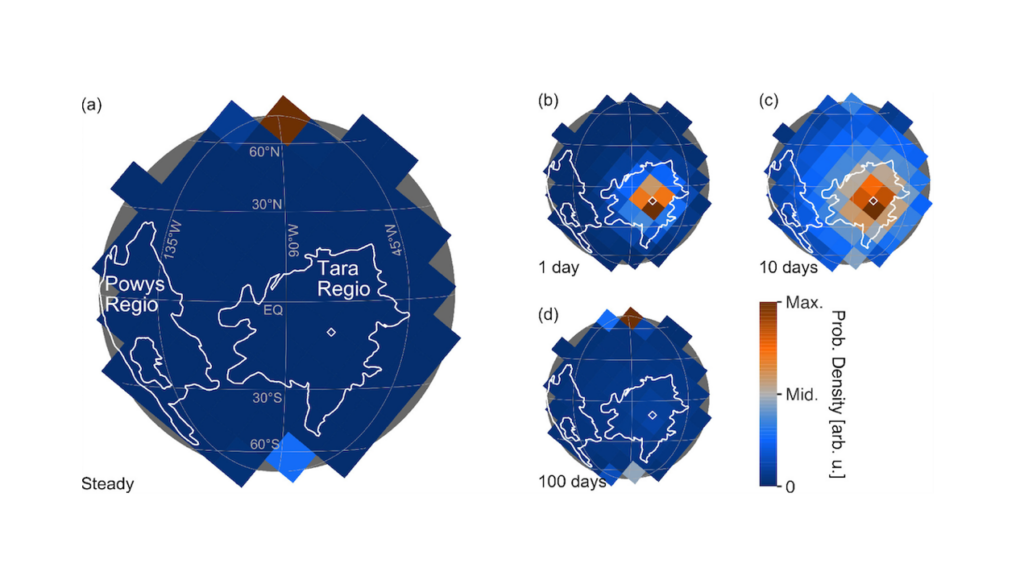The NOW NASA Decadal Astrobiology Research and Exploration Strategy Position Paper

Ocean Worlds Exploration and the Search For Life
Authors: NOW Co-Leads & Steering Committee
- Network for Ocean Worlds (NOW)
- The NOW NASA Decadal Astrobiology Research and Exploration Strategy Position Paper (with endorsements)
- Original posting
Preamble
Ocean Worlds in the outer Solar System, with liquid water oceans in contact with rocky seafloors, represent the highest priority for our community in the search for extant life beyond Earth [1]. While no such environments were known to exist at the start of the millennium, it is not hyperbolic to reflect, with current knowledge, that NASA spacecraft may already have flown beyond inhabited planetary bodies [2]. Simultaneously, it is now recognized that a wealth of exoplanets discovered to-date, orbiting other stars, may also be ocean worlds [3]. These inferences, if proven to be accurate, would be transformative for the biological potential of the Universe.
Introduction
We recommend the establishment of a dedicated Ocean Worlds Exploration Strategy, centered within the NASA Astrobiology program and spanning across multiple NASA divisions including, within SMD: Planetary Sciences, Earth Sciences and Astrophysics. The development of such a strategy, as recommended by the Decadal Survey for Planetary Sciences and Astrobiology, “Origins, Worlds & Life (OWL)” [1], would be particularly valuable for providing sustained funding to support the science, engineering, research, technology development, and mission planning needed to implement our vision of a multi-decadal, multi-mission program to explore ocean worlds: to understand the conditions for habitability, and to search for life.
Beyond the Europa Clipper (habitability-oriented) mission, which will conduct its primary mission between 2031 and 2034 [4], the next critical flagship mission identified in OWL would be to orbit Enceladus and then land near its south pole to search for evidence of life [5].
Looking ahead, however, our Ocean Worlds Exploration Strategy should also anticipate the need for a follow-on Flagship Mission and prepare to access the interior ocean of an ice-covered ocean world to search for life.
Importantly, the technological solutions for a landed mission are already in-hand, as evidenced by the Europa Lander pre-project, which passed its delta-Mission Concept Review as long ago as Fall, 2018. By contrast, an ocean access mission will extend, audaciously, beyond any mission previously attempted by NASA or any other nation’s space program. To be ready to rise to such a challenge, as soon as the opportunity arises, will require substantial research, development, and analog testing of both platforms and cutting edge in situ sensing: work that should begin, imminently.
Note that this ambitious goal could not have been put forward with such credibility, before now. Both science and technology have matured sufficiently that we can now prioritize the direct search for signs of life beyond Earth, applying lessons learned from planetary and Earth exploration to conduct in situ investigations of worlds where water and life are most likely to exist today.
This new era of planetary investigation will require significant support for cross-disciplinary research and development, bringing together planetary scientists and engineers with those that study Earth. All facets of this Ocean Worlds Exploration Strategy must actively ensure equitable access and inclusion across the spectrum of contributors in Planetary Science, Exploration, and Astrobiology. To chart these new waters, a diversity of disciplines must be accompanied by a diversity of experience, skill, and perspective.
Hence, an Ocean Worlds Exploration Strategy should include specific initiatives designed to attract, entrain and retain scientists and technologists from multiple scientific backgrounds (e.g., government, academia, private sector) and to train the next generation of ocean world explorers who will be needed to implement such a multi-mission strategy and bring our vision to realization. Such an Ocean Worlds Exploration Strategy, as it is implemented, will spur a new era of innovation within NASA as it pursues one of the most fundamental science quests of the Science Mission Directorate as a whole: the search for life elsewhere [6].
Science Drivers
The recognition that life can be sustained in Earth’s deep ocean where sunlight does not penetrate [7] made the discovery of a global saltwater ocean beneath Europa’s icy shell a watershed moment in Planetary Science and Astrobiology [8]. Two decades later, the ocean worlds of the outer solar system now present the best opportunity to find life in several possible states: alive and active, alive but dormant, or life-like in form but no longer living [9].
The excitement associated with ocean worlds is rallying a diverse new cohort of scientists and technology developers to this cause: experts in Earth’s oceanography, glaciology, polar environments, and extreme-environment microbiology, who have not historically been involved in solar system exploration, are now engaged.
The blend of planetary scientists from traditional disciplines such as geophysics, geochemistry, orbital dynamics, and astronomy with terrestrial ocean and cryosphere scientists can meaningfully advance theoretical modeling, comparative planetology, habitability-targeted laboratory experiments, and analog field studies. Simultaneously, studies of ocean worlds offer a compelling opportunity to challenge our understanding of habitability beyond our Solar System [3].
Europa and Enceladus possess global oceans in direct contact with rocky interiors, providing the potential for water-rock reactions and a range of environments in which life could emerge and persist [2]. Importantly, they also exhibit evidence for on-going geologic activity, permitting surface-interior material transport that can maintain chemical disequilibria in the ocean and at its interfaces.
Thus, the key components for life are present: water, chemical building blocks in disequilibrium, energy, and time. Consequently, Europa and Enceladus have been identified as key targets in the search for extant life [1]. Further, penetrating through their icy shells, which may be kilometers to tens-of-kilometers thick, is becoming ever more practicable [10, 11].
Priority missions for an Ocean Worlds Exploration strategy
Embodied in the search for life is a focus on the planetary and local (surface and subsurface) conditions that enable (or restrict) the emergence and persistence of life. This includes exploring the range of habitable environments present in the outer Solar System and expanding our techniques for accessing potential habitats as well as enhancing technology and science enabling the detection of signs of past or present life. Hence, the search for life among Ocean Worlds can only fulfill a major role in astrobiology if it simultaneously addresses key questions related to planetary systems, focusing on the physical and chemical processes that shape these environments (Table 1).
Here we outline a systematic pathway to ocean access and life detection in the coming decades, building upon both completed missions (Voyager, Galileo, Cassini) and those that have recently been launched: NASA’s flagship Europa Clipper fly-by mission to Europa and ESA’s L-class JUICE mission – the first designed to assess the relative habitability of multiple ocean worlds within a single planetary system. Timely completion of the Europa Clipper mission, and sustained international partnership in ESA’s JUICE mission, are central to advancing the field of Astrobiology in the coming decade.

Table 1 | NOW priority themes and questions in Planetary Science and Astrobiology.
The most critical new mission in the coming decade, to progress towards life detection, is a landed mission to an ocean world. Encouragingly, an Enceladus Orbiter/Lander hybrid is now a recommended priority for both NASA’s Planetary Sciences Division [1] and for the European Space Agency’s next L-class mission [12]. The Enceladus OrbiLander mission concept [5], as well as the detailed Europa Lander Science Definition Team report [13], provide strong science rationales for biosignature detection and environmental investigation of an ocean world’s planetary surface.
Chemistry resulting from life may be retained in the non-ice materials of an ocean world’s ice shell (e.g. organics or inorganics structurally modified by life, by-products of metabolism), providing compelling evidence for the existence of life, even in the absence of life-form detection. Likewise, physical structures of life, or components thereof, could also be present. Detecting these biosignatures is a priority science objective for any in situ ocean worlds mission.
In addition to the search for biosignatures on an Ocean World, a landed mission would simultaneously advance our understanding of geophysical and geologic context: key data that are invaluable for ground-truthing of remote sensing data. Well-defined measurements will provide a strong foundation for inferences regarding the balance of physical and chemical processes in the ice and ocean, as well as their influences on habitability. Even in the case of a non-biosignature detection, landed surface measurements will be informative on the impact of surface processes (including processing by any incident radiation) on the potential for biosignature prevalence and degradation.
Further, a landed ocean world mission (e.g. Enceladus OrbiLander) will enable future ocean access and direct life detection in a planetary ocean, where the most habitable interfaces are likely located [14]. Characterizing the environments on the surfaces of and within ocean world ice shells will provide key engineering and design constraints for ice and ocean access technologies already under preliminary development and retire risks associated with landing and deploying such payloads.
In 2018, the Europa Lander pre-project passed its delta Mission Concept Review, proving Pre-Phase A readiness to land on an icy airless body with unknown lander-scale surface topography in the outer solar system. We therefore support the recommendation of the most recent NASA Planetary Science and Astrobiology decadal survey that a landed flagship mission capable of performing in situ biosignature detection and ascertaining the geophysical and geochemical conditions on Enceladus be selected and advanced as rapidly as possible.
If a landed flagship mission to Enceladus cannot be advanced in timely fashion, a fall-back could be to pursue an Enceladus plume fly-through mission. Recent proposals have already demonstrated that such a mission could be accomplished under New Frontiers. The unparalleled cryovolcanic activity at the south pole of Enceladus [5], which may also be replicated at Europa [15, 16], offers a window into the habitability, chemistry, and geologic processes active within such bodies.
Sampling and analyzing material from plume ejecta, while characterizing any corresponding mechanical or geodetic changes in the ice shell, would allow high-fidelity investigations of interior volatile reservoirs and their habitability, illuminate geologic environments and processes, and still, potentially, allow for biosignature detection.
Research and Analysis
At the core of an Ocean Worlds Exploration Strategy should be a well-funded and sustained research and analysis (R&A) program. Priorities should include continued support for analyses of past, current, and future mission data, while encouraging new and novel studies into ocean world processes—including the emergence, persistence, and biogeochemical ramifications of life. This approach will broaden our understanding of the key measurements needed to confirm life beyond Earth. Supporting theoretical, laboratory, modeling, and terrestrial investigations into comparative oceanography, ice physics, and multi-disciplinary cryosphere research will build an empowered community capable of answering key questions to guide future exploration.
Establishing benchmarks for detection, based on Earth observations in the multitude of analog habitats on Earth is a critical need identified in the Europa Lander Study [13]. Likewise, advancing understanding of life and its preservation in Earth’s ocean and cryosphere, life-associated products and processes and discernment of biosignatures from confounding abiotic signatures (e.g., dark oxygen production in the deep sea) will better prepare the scientific community for ocean world missions and data interpretation.
We are fortunate to live on and explore an ocean world. Strong synergies between icy moon exploration and the studies of polar oceans and ices on Earth can expand our capabilities for interrogating these environments throughout the Solar System. An Ocean Worlds Exploration Strategy geared for success in the search for life must devote significant efforts to developing exploration technologies and instruments (and associated detection limits), which should include a strong analog testing capability [17]. We recommend that analog research and field testing of exploration technologies and instrumentation continue under expanded and sustained funding.
As we understand the increasing likelihood that ocean worlds are common in other solar systems, accounting for potentially 1-in-4 volcanically active exoplanets [3], fostering enhanced collaborations with exoplanet researchers (e.g. via NExSS) may yield new and stimulating ideas about the habitability of other worlds.
Exploration Technology Development
In 2017, a Keck Institute for Space Studies (KISS) investigation [10] concluded that, for the first time, the science and technology of ocean access have reached a level of maturity to credibly enable flight implementation within the next two decades. NASA’s Science Mission Directorate has since taken important next steps towards ocean access by establishing, first, the Scientific Exploration Subsurface Access Mechanism for Europa (SESAME) program and a follow-on series of projects supported via the COLDTech program [18]. Such support will need to be sustained going forward, to develop both platforms and payload.
Strategic Partnerships
Coordinated ocean worlds studies at NASA will connect stakeholders across Astrobiology RCNs and, indeed, the entire Science Mission Directorate, spurring interdisciplinary research. Historically, outer solar system missions have been exclusive to NASA and ESA, but ISRO and JAXA now have the science, technology, and mission planning readiness to execute ocean worlds missions as well.
Elsewhere within the US, NSF’s Geosciences Directorate provides primary support for studying Earth’s cryosphere and oceans – critical to validating ocean worlds exploration technologies and scientific payloads. NOAA also coordinates a national program of Ocean Exploration and Research that prioritizes the development and use of uncrewed marine systems.
Consequently, we recommend that NASA partner with NSF, and NOAA to coordinate an Ocean World Exploration Strategy that incentivizes both government and private entities to engage a diversity of expertise to pursue the unprecedent opportunities now on offer.
References
[1] NASEM (2023), Origins, Worlds and Life. Nat. Acad. Press. https://doi.org/10.17226/26522.
[2] Hand, K.P., et al. (2020) Space Sci. Rev. 216, https://doi.org/10.1007/s11214-020-00713-7
[3] Quick, L. et al. (2020) PASP 132, doi:10.1088/1538-3873/ab9504;
[4] Pappalardo, R.T. et al. (2024), Space Sci. Rev. 220, https://doi.org/10.1007/s11214-024-01070-5
[5] MacKenzie, S. M., et al. (2021) Planet. Sci. J. 2, doi: 10.3847/PSJ/abe4da
[6] NASA (2020) https://science.nasa.gov/wp-content/uploads/2024/07/2020-2024-science.pdf
[7] Corliss, J.B. et al. (1979) Science 203, 1078-1083.
[8] Kivelson, M.G., et al. (2000) Science 289, DOI: 10.1126/science.289.5483.1340
[9] Neveu, M. et al. (2018) Astrobiology 18, doi:10.1089/ast.2017.1773
[10] Sotin, C. et al. (2017) https://www.kiss.caltech.edu/workshops/oceanworlds/oceanworlds.html
[11] Cowing, K. (2023) https://astrobiology.com/2023/12/nasa-studies-cryobots-to-explore-oceanworlds.html
[12] Martins, Z et al. (2024), Expert Committee for the Large-class mission in ESA’s Voyage 2050 plan,
https://www.cosmos.esa.int/documents/1866264/1866292/ESA_L4_Expert_Committee_report_Voyage _2050_Moons_of_the_Giant_Planets.pdf.
[13] Hand, K.P., et al. (2022), Planet. Sci. J. 3, doi.org/10.3847/PSJ/ac4493.
[14] NASEM (2018), Astrobiology Strategy & Search for Life. Nat. Acad. Press. doi:10.17226/25252;
[15] Jia, X. et al., (2018), Nat. Astron. 2, doi: 10.1038/s41550-018-0450-z
[16] Paganini, L. et al. (2020), Nat. Astron. 4, doi:10.1038/s41550-019-0933-6
[17] Stone, W.C. et al (2021) PSADS White Paper #416. doi: 10.3847/25c2cfeb.dd2ee692
[18] https://www1.grc.nasa.gov/space/pesto/investment-areas/coldtech/
Astrobiology








